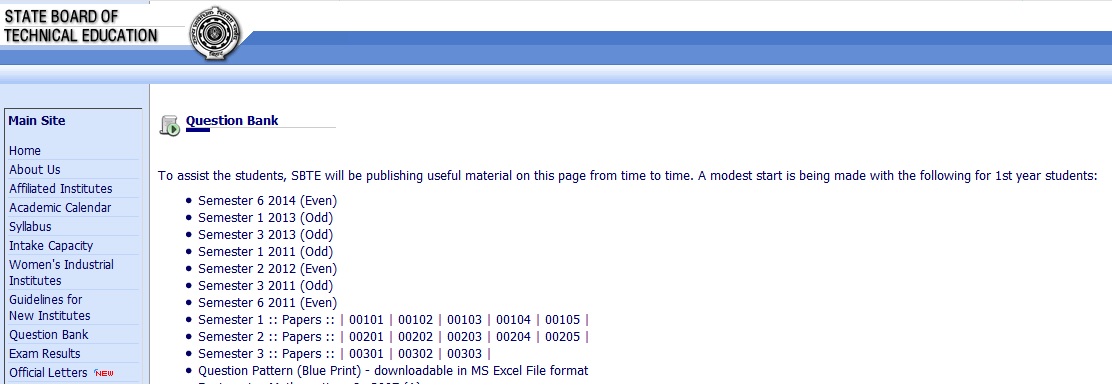sbtebihar.gov.in 1st Year Elementary Mechanical Engineering & Material Question Bank : Bihar State Board of Technical Education
Board : State Board of Technical Education
Subject : Elementary Mechanical Engineering & Engineering Material
Document Type : Question Bank
State : Bihar
Website : sbtebihar.gov.in
Download Model/Sample Question Paper : https://www.pdfquestion.in/uploads/7358-00107.pdf
SBT Bihar Mechanical Engineering Question Paper
1st Year Elementary Mechanical Engineering and Engineering Material Question Bank:
Time : 3 Hrs.
Full Marks : 80
Pass Marks : 26
Note :
1. Answer from both groups separately and in sequence as per direction given in each case in own words.
Related : Bihar State Board of Technical Education 1st Year Basic Engineering Drawing Question Bank : www.pdfquestion.in/7357.html
2. All question of Q.No.1 of each Group-A and B are compulsory.
3. The figures in right hand margin indicate full marks.
Group-A
[Mechanical Portion]:
1.(A) Select correct alternative of each of the following :- 1×5=5
(i) Flux commonly used in brazing is:
(a) Zince chloride
(b) Ammonium chloride
(c) Resin mixed with alcohol
(d) borax.
(ii) Intensive property of a thermodynamic system is:
(a) dependent upon mass
(b) independent of mass
(c) dependent upon energy
(d) dependent upon both mass and energy.
(iii) Function of an ‘Economizer’ in a boiler is :
(a) to make the boiler cheaper
(b) to use the steam again and again
(c) to utilize heat of flue gases
(d) all of the above.

(iv) Guages are used to :
(a) measure length
(b) measure angular distance
(c) check dimensional accuracy
(d) all of the above.
(v) Reciprocating motion of piston is converted to rotary motion by :
(a) piston and crank mechanism
(b) cylinder and piston mechanism
(c) flywheel and crank mechanism
(d) connecting rod and crank mechanism.
(B) Write True for correct statement and False for wrong statement : 1×5=5
(i) 2-stroke engine has two power strokes in one revolution of crank.
(ii) Primary function of mountings on a boiler is to provide safe working of the boiler.
(iii) Crowning of a pulley is done to prevent a belt on it from running off the pulley.
(iv) Forge welding is basically a fusion welding.
(v) Welding of steel using oxidising flame increases the strength of steel.
2. Answer any two questions : 5×2=10
(a) Differentiate a 2-stroke and a 4-stroke engine.
(b) What are the selection criteria of gear, belt and chain drive? Explain in brief.
(c) Classify boilers and name some of them.
(d) Write differences between soldering and brazing.
3. Answer any two questions : 10×2=20
(a) What are the different type of flames used in welding by oxy-acelyline gas ? Explain them with uses.
(b) Describe with neat sketch a micrometer. What are its applications ?
(c) Define welding. Explain arc welding on the basis of types of electrodes.
(d) Describe with P-V diagram the working of a 4-stroke Diesel engine.
Group-B
[Engineering Material]:
1. Select correct alternative of each of the following :- 1×10=10
(i) The rocks which are formed from molten magma are called :
(a) sedimentary rocks
(b) Igneous rocks
(c) Metamorphic rocks
(d) stratified rock.
(ii) The size of modular bricks is :
(a) 22.5 cm x 10 cm x 8.5 cm
(b) 19 cm x 9 cm x 9 cm
(c) 22.5 cm x 9 cm x 8 cm
(d) None of the above.
(iii) The main ingredient of a good quality brick earth is:
(a) magnesia
(b) alumina
(c) silica
(d) All of the above.
(iv) The property by virtue of which lime sets under water is known as :
(a) slacking
(b) bulking
(c) hydraulicity
(d) calcining.
(v) Ordinary portland cement achieves about 70% its final strength in :
(a) 21 days
(b) 28 days
(c) 14 days
(d) None of these.
(vi) Knots in timber is caused by defects due to :
(a) fungi
(b) insects
(c) natural forces
(d) Seasoning.
(vii) The commonly used the base of oil paints is :
(a) red lead
(b) iron oxide
(c) White lead
(d) Whiting.
(viii) The percentage of carbon in wrought iron is :
(a) 2 to 3.5%
(b) 0 to 0.25%
(c) 0.5 to 0.7%
(d) 0.15 to 1.5%
(ix) Brass is an alloy of :
(a) copper, zinc and minor percentage of other element.
(b) copper, tin and minor percentage of other element.
(c) copper, nickel and minor percentage of other element.
(d) none of these.